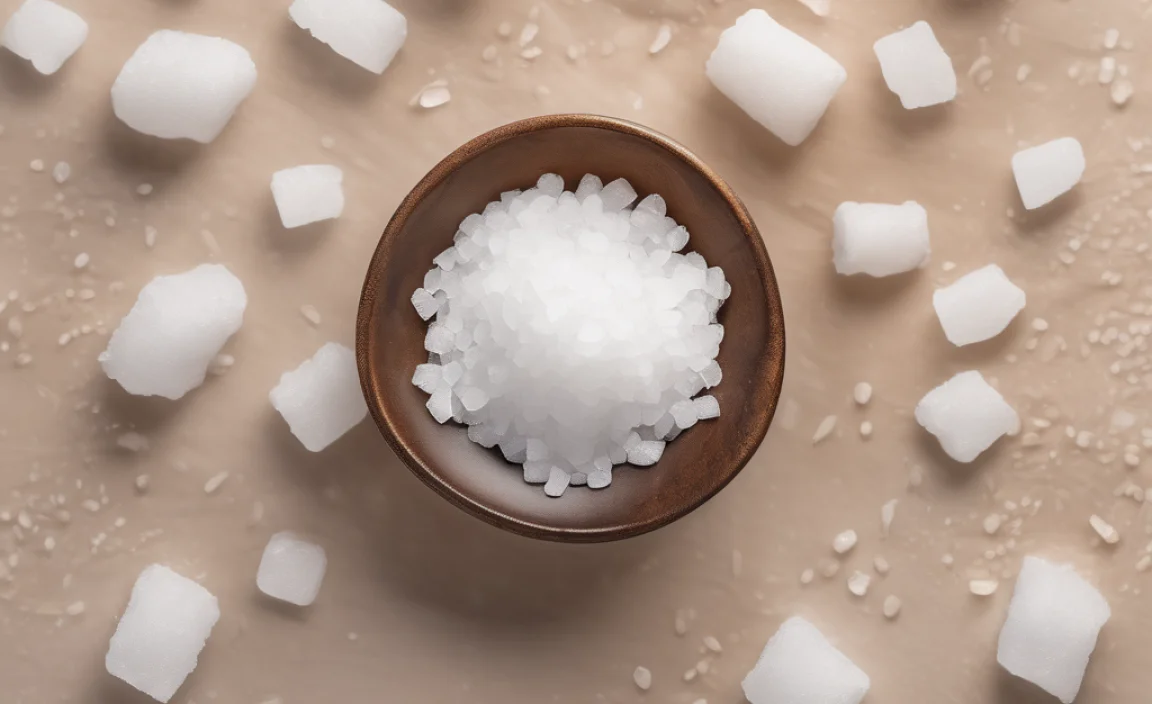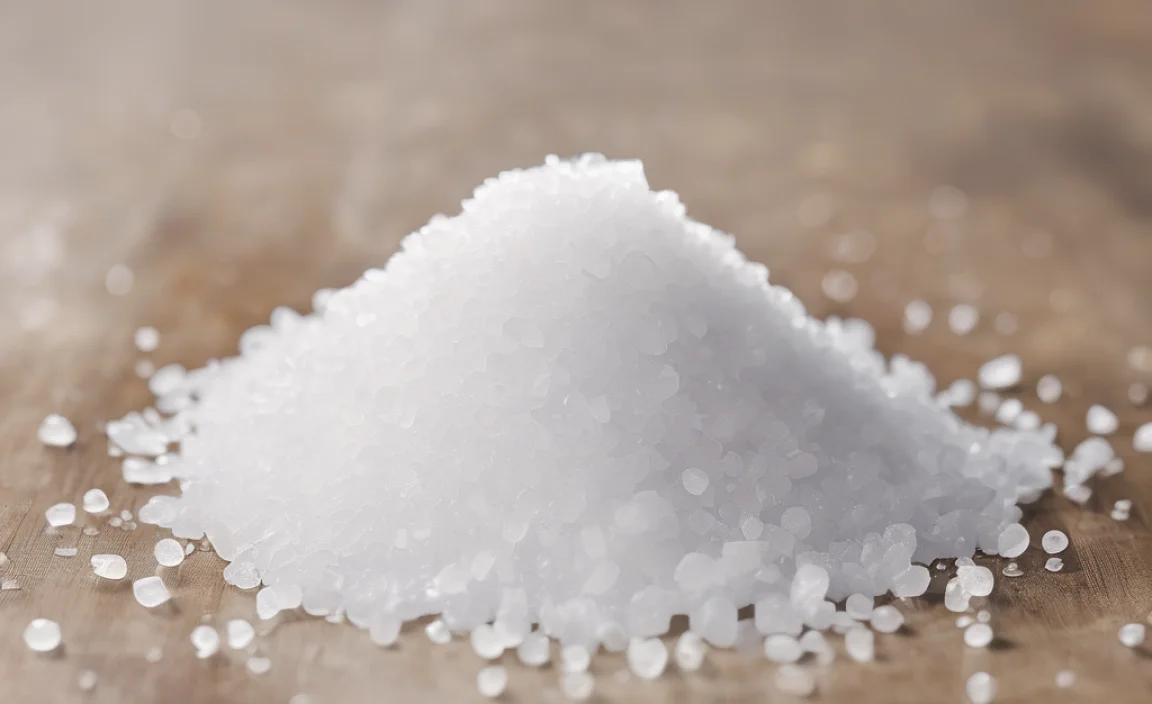Quick Summary: No, water softener salt is not edible. While it’s primarily sodium chloride (like table salt), it often contains additives and impurities that make it unsafe for consumption. Eating water softener salt can lead to health issues. Stick to regular table salt or sea salt for your culinary needs!
Ever wondered if that big bag of water softener salt could double as table salt in a pinch? It’s a common question! Many folks see “salt” and assume it’s all the same. But using the wrong kind of salt can be harmful. We’ll walk you through why water softener salt isn’t for eating. We’ll also cover what it’s used for, what it contains, and the potential risks of eating it. Let’s keep you and your family safe and healthy!
What is Water Softener Salt?

Water softener salt is designed to remove minerals from your water. These minerals, like calcium and magnesium, cause hard water. Hard water can lead to scale buildup in pipes and appliances. It also makes it harder for soaps and detergents to lather.
Water softeners use a process called ion exchange. In this process, hard water flows through a tank filled with resin beads. These beads are charged with sodium ions. The resin beads attract and hold the calcium and magnesium ions, releasing sodium ions into the water. Over time, the resin beads become saturated with calcium and magnesium. That’s where the salt comes in.
Water softener salt is used to regenerate the resin beads. A brine solution, made from the salt, washes over the beads. This highly concentrated salt solution forces the calcium and magnesium ions off the resin beads. Then the beads are recharged with sodium ions, ready to soften more water. The wastewater, containing the displaced calcium and magnesium, is flushed out of the system.
Types of Water Softener Salt
There are several types of water softener salt available. Let’s take a look at the most common ones:
- Rock Salt: This is the least expensive option. It’s mined from underground deposits. Rock salt contains impurities that can build up in your water softener tank.
- Solar Salt: Solar salt is made by evaporating seawater. It’s purer than rock salt but still contains some insoluble minerals.
- Evaporated Salt Pellets: These pellets are made by evaporating salt brine. They are very pure and dissolve evenly. This makes them a good choice for water softeners.
- Salt Blocks: These large blocks of salt dissolve slowly. They are easy to handle and reduce the risk of bridging in the brine tank.
Why Water Softener Salt is Not Edible

While water softener salt is primarily sodium chloride, like table salt, there are crucial differences. These differences make it unsafe for human consumption.
Additives and Impurities
Water softener salt often contains additives to prevent clumping and maintain its structure. These additives are not food-grade and can be harmful if ingested. For example, some salts contain iron-removing additives. These are great for your appliances, but not for your body.
Additionally, water softener salt, especially rock salt, contains impurities. These impurities can include dirt, minerals, and other substances that are not safe to eat. Even solar salt, which is purer, can contain traces of insoluble materials.
Lack of Regulation
Table salt is regulated for human consumption. This means it must meet specific standards for purity and safety. Water softener salt is not subject to these regulations. Manufacturers don’t have to ensure it’s free from harmful contaminants. This lack of oversight makes it unsuitable for cooking or seasoning food.
Potential Health Risks
Eating water softener salt can lead to several health problems. The additives and impurities can cause digestive issues, such as nausea and diarrhea. Ingesting large amounts can also lead to electrolyte imbalances. This can affect nerve and muscle function.
People with certain health conditions, such as high blood pressure or kidney problems, should be especially cautious. The high sodium content in water softener salt can worsen these conditions.
Comparing Water Softener Salt and Table Salt

Let’s break down the key differences between water softener salt and table salt in a table format:
| Feature | Water Softener Salt | Table Salt |
|---|---|---|
| Purity | Lower, contains additives and impurities | High, regulated for human consumption |
| Additives | Contains anti-caking agents and other non-food-grade additives | May contain iodine, an essential nutrient |
| Regulation | Not regulated for human consumption | Regulated by food safety authorities |
| Intended Use | Regenerating water softener resin beads | Seasoning food, cooking |
| Health Risks | Potential digestive issues, electrolyte imbalances | Excessive intake can lead to high blood pressure |
What Happens if You Eat Water Softener Salt?
Accidentally ingesting a small amount of water softener salt is unlikely to cause serious harm. However, eating a significant quantity can lead to several adverse effects.
Immediate Effects
- Nausea: The additives and impurities can irritate the stomach lining, causing nausea.
- Vomiting: Your body may try to expel the harmful substances by inducing vomiting.
- Diarrhea: The digestive system may react by speeding up the elimination process, leading to diarrhea.
- Dehydration: Vomiting and diarrhea can lead to dehydration, which can be dangerous if not addressed.
Long-Term Effects
- Electrolyte Imbalance: High sodium intake can disrupt the balance of electrolytes in your body. This can affect nerve and muscle function.
- High Blood Pressure: Excessive sodium consumption can raise blood pressure. This increases the risk of heart disease and stroke.
- Kidney Problems: The kidneys may struggle to process the high sodium load. This can worsen existing kidney conditions.
What to Do If You Ingest Water Softener Salt
If you or someone else has eaten a significant amount of water softener salt, here’s what you should do:
- Drink Plenty of Water: This helps to dilute the salt and flush it out of your system.
- Monitor Symptoms: Watch for signs of nausea, vomiting, diarrhea, and dehydration.
- Seek Medical Advice: If symptoms are severe or persistent, contact a doctor or poison control center immediately.
Safe Alternatives for Salt
Now that you know water softener salt is off the menu, let’s explore safe and delicious alternatives for your culinary needs.
Table Salt
Table salt is the most common type of salt used for cooking and seasoning. It’s highly refined and usually contains iodine, which is essential for thyroid function. Table salt has a fine texture and dissolves easily, making it ideal for general use.
Sea Salt
Sea salt is made by evaporating seawater. It retains trace minerals that give it a more complex flavor compared to table salt. Sea salt comes in various grain sizes, from fine to coarse. It’s great for finishing dishes or adding texture to your meals.
Kosher Salt
Kosher salt is a coarse-grained salt that’s popular among chefs. It doesn’t contain iodine or additives. Its large crystals make it easy to pinch and sprinkle. Kosher salt is excellent for seasoning meats and vegetables.
Himalayan Pink Salt
Himalayan pink salt is mined from ancient salt deposits in the Himalayas. It gets its pink color from trace minerals like iron, potassium, and magnesium. Many people like it for its unique flavor and health benefits. It can be used in cooking, baking, and as a finishing salt.
How to Store Salt Properly
Proper storage is essential to maintain the quality and flavor of your salt. Here are some tips to keep your salt fresh and dry:
- Airtight Containers: Store salt in airtight containers to prevent moisture absorption.
- Cool, Dry Place: Keep salt away from heat and humidity. A pantry or cupboard is ideal.
- Avoid Metal Containers: Metal containers can react with salt, affecting its flavor. Use glass, ceramic, or plastic containers instead.
- Label Containers: Clearly label your salt containers. This prevents confusion, especially if you have multiple types of salt.
FAQ: Is Water Softener Salt Edible?
Here are some frequently asked questions about water softener salt and its edibility:
Q1: Can I use water softener salt for cooking?
A: No, water softener salt is not safe for cooking. It contains additives and impurities that are not food-grade.
Q2: What happens if I accidentally use water softener salt in my food?
A: A small amount is unlikely to cause serious harm. However, avoid consuming large quantities and monitor for any adverse symptoms.
Q3: Is there any type of water softener salt that is safe to eat?
A: No, none of the water softener salts are safe to eat. Always use food-grade salt for cooking and seasoning.
Q4: Can I use table salt in my water softener?
A: No, table salt is not suitable for water softeners. It can contain additives that damage the system. Use only salt specifically designed for water softeners.
Q5: What are the best alternatives to table salt for cooking?
A: Safe alternatives include sea salt, kosher salt, and Himalayan pink salt. Each offers unique flavors and textures.
Q6: How can I tell the difference between water softener salt and table salt?
A: Water softener salt often comes in large crystals or pellets and is labeled specifically for water softeners. Table salt is finely ground and packaged for culinary use.
Q7: What should I do if my child eats water softener salt?
A: Contact your local poison control center or seek medical attention immediately. Provide them with information on how much salt was ingested.
Conclusion
So, is water softener salt edible? The answer is a clear and resounding no. While it might look like regular salt, it contains additives and impurities that make it unsafe for human consumption. Sticking to food-grade salts like table salt, sea salt, or kosher salt is always the safest bet for your cooking and seasoning needs.
Understanding the differences between various types of salt and their intended uses is crucial for maintaining your health and the longevity of your appliances. Always read labels carefully and store your salts properly to avoid any mix-ups. Now you can confidently season your food, knowing you’re making a safe and healthy choice. Happy cooking!
